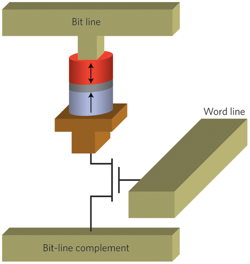New Spin on Magnetic Memories
Solid-state memory devices with all-electrical read and write operations might lead to faster, cheaper information storage.
By Francis Pelletier | March 16, 2015 at 2:22 pmNature Nanotechnology has published an article written by Andrew D. Kent, department of physics, New York University, New York, NY, and Daniel C. Worledge, IBM T. J. Watson Research Center, Yorktown Heights, New York, NY.
A magnetic tunnel junction is formed by a fixed reference layer (purple), a tunnel barrier (grey) and a free-layer element (red), with both layers magnetized perpendicular to the plane of the junction (black arrows). The bit is selected by a word line and transistor, and operated by applying biases to the bit lines
Abstract: “Spin-transfer-torque magnetic random access memory (STT-MRAM) devices store information in the orientation of the magnetization of nanometre-scale ferromagnetic elements. As such, they are like hard disk drives, which use magnetic states to store information. In contrast to hard disk drives, however, STT-MRAM is written and read electrically, and does not have moving parts. This is a key difference that enables the integration of magnetic devices with semiconductor chips. Such devices might fulfil the speed requirements of a computer’s working memory while having the inherent advantages of using magnetic states — that no energy is needed to retain information.“














 Subscribe to our free daily newsletter
Subscribe to our free daily newsletter

